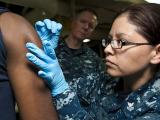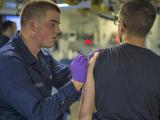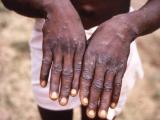Jan 31, 2003 (CIDRAP News) Only two cases of "noteworthy" complications from smallpox vaccination have occurred among tens of thousands of troops who have received shots since the military vaccination program began in mid-December, according to a Department of Defense (DoD) report released today.
The report says that 3% of vaccinees have taken sick leave, averaging 1½ days, after vaccination. Symptoms have been those often seen after the shot, including itching, swollen lymph nodes, fever, and malaise, officials said. There have been no deaths and no transmission of vaccinia virus from vaccinees to others.
The two noteworthy complications include one case of encephalitis that may be related to the vaccine and one apparent case of generalized vaccinia, according to the DoD report. The solider with encephalitis is in good condition, and the one with generalized vaccinia is well and continuing to work. Their names were not released.
The report quotes William Winkenwerder Jr, MD, assistant secretary of defense for health affairs, as saying, "Our safety experience with smallpox vaccinations to date is consistent with what we expected overall. We have seen a small number of adverse reactions to the vaccine, mostly minor. There have been two significant reactions. We can expect additional reactions to occur; some will be significant reactions."
The report says 3,665 military healthcare workers have been vaccinated since the program began in mid-December. The number of other military personnel who have received shots was not disclosed, but it exceeds "several tens of thousands," the report states.
The solider with encephalitis is a 23-year-old man who was admitted to an overseas military hospital Jan 26, eight days after he was vaccinated, according to DoD. Diagnostic studies did not point to the vaccine as the cause, but the possibility is still being investigated. "He has markedly improved, is in good condition, and is expected to be released from the hospital soon," the report states.
Post-vaccinial encephalitis was very rare in the smallpox eradication era, with rates in the 1960s ranging from about 3 to 12 cases per million first-time vaccinees, according to the Centers for Disease Control and Prevention (CDC). The complication was fatal in about 15% to 25% of cases in the United States.
The soldier with apparent generalized vaccinia is a 30-year-old man at a US base who developed a rash that included several pustules about 10 days after his vaccination, according to the report. "The solider is well and continues to work at his usual location," the report says. Generalized vaccinia is usually self-limiting in otherwise healthy people, according to the CDC. A 10-state survey in 1968 put the incidence of generalized vaccinia at about 241 cases per million primary vaccinees.
DoD reports that sick-leave rates so far have varied with previous vaccination status: Four percent to 5% of primary vaccinees have needed sick leave, compared with 1% to 2% of those who were vaccinated previously.
The report says there have been no cases requiring the use of vaccinia immune globulin, which is used to treat complications such as eczema vaccinatum, progressive vaccinia, and severe generalized vaccinia. No cases of auto-inoculation, or spreading of vaccinia from the inoculation site to other body sites, have been reported.



















